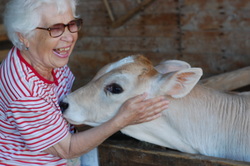 Did you know that Yoga was not always taught to women? In male dominated India women faced many rules and restrictions related to their menstrual cycle - in some cases they were declared ‘untouchable’ for the duration of this period. Fortunately, modern knowledge has changed this situation, and now more women-practitioners (termed ‘yogini’) are entering the spiritual and physical world of Yoga. According to Chandra Cuffaro, a yoga teacher from the Krigshnamacharya Health and Yoga Foundation in Rome as well as a long-time practitioner, women go through seven parinamas (transformations) throughout their lives. Yoga helps to cope with these transformations, and offers much needed support during these times. The first parinama occurs during puberty when a girl’s body changes and takes on a more rounded shape. Often, especially in modern times, these changes can be regarded as negative and undesirable. Yoga helps young girls understand their bodies and the changes that come with physical maturation; they learn to appreciate their new form and properly maintain it through exercise and a balanced diet (not starvation). The second parinama happens when the young woman marries and has to adjust to a new life with another person. Marriage means ‘sharing’ and sharing means adjusting. Everything in her life is going to be different now, and Yoga, especially the spiritual, meditative part will offer a great deal of mental help. The third parinama is pregnancy. A woman’s physiological and emotional levels are suddenly and simultaneously exploding; she has no idea how to handle this situation. Yoga provides a phenomenal balancing power that gives stability and calm, and allows the woman to enjoy this precious moment of binding with another being. The fourth parinama extends throughout the entire period of pregnancy – it encompasses a major transformational period which alters the woman biologically and mentally. Again, through regular practice Yoga helps build the most wonderful relationship between the mother and baby. We now arrive at the time of delivery – the fifth parinama. Along with joy there is always fear of pain, problems with delivery, concerns for the child’s health, and much more. These worries could be overwhelming for a woman, and may intensify any upcoming issues if she is not adequately prepared. Regular Yoga practice during pregnancy can increase focus and build proper breathing techniques thereby attenuating any possible negative outcomes. At this point you can probably guess that the sixth parinama is the post-partum time when a woman is adjusting to less sleep, less time for herself, and establishing an amazing connection with the newborn. In many cases a woman must show her husband that his role as a father is very important, that she needs his help. The Yoga practice could be of utmost importance, and gives direction on how to manage this change. A long time will pass between the sixth and the seventh and last parinama. The woman will face many adjustments, but she will be ready through her continuous Yoga practice. Menopause will constitute the last stage in a woman’s transformation cycle. Chandra Cuffaro calls it ‘the phase of serenity’ when results are not as important as the quality of doing; it is the time of peace and wisdom.
2 Comments
6/9/2015 03:14:10 am
I salute this blog author because they all time provide very useful yoga related tips and advice. This all tips improve my yoga practice day by day.
Reply
Your comment will be posted after it is approved.
Leave a Reply. |
AUTHOR
Mariya Power has a Master's Degree in Nutrition and Food Science from the University of Vermont; has conducted research on effects of cinnamon extract in type II diabetes, and is a passionate yoga enthusiast. Archives
March 2015
Categories
All
|
Web Hosting by IPOWER
 RSS Feed
RSS Feed